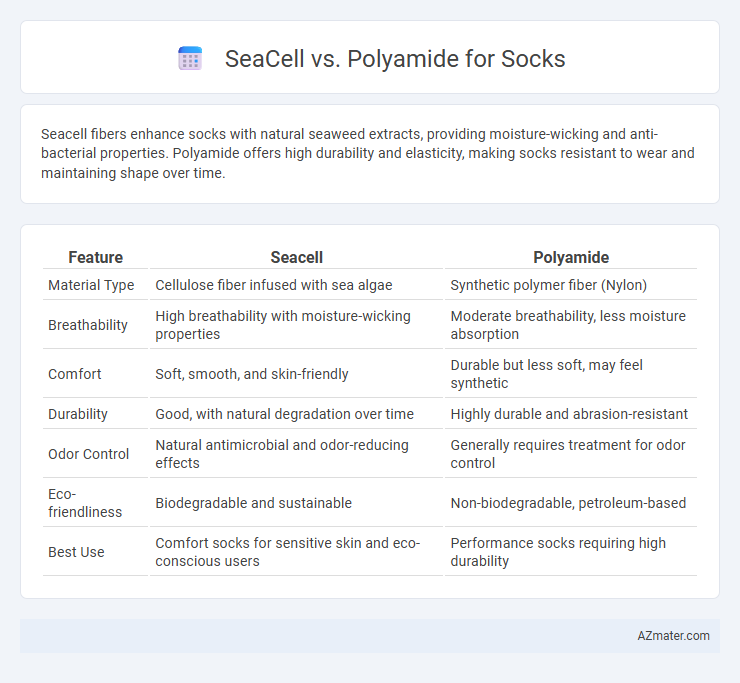Seacell fibers enhance socks with natural seaweed extracts, providing moisture-wicking and anti-bacterial properties. Polyamide offers high durability and elasticity, making socks resistant to wear and maintaining shape over time.
Table of Comparison
| Feature | Seacell | Polyamide |
|---|---|---|
| Material Type | Cellulose fiber infused with sea algae | Synthetic polymer fiber (Nylon) |
| Breathability | High breathability with moisture-wicking properties | Moderate breathability, less moisture absorption |
| Comfort | Soft, smooth, and skin-friendly | Durable but less soft, may feel synthetic |
| Durability | Good, with natural degradation over time | Highly durable and abrasion-resistant |
| Odor Control | Natural antimicrobial and odor-reducing effects | Generally requires treatment for odor control |
| Eco-friendliness | Biodegradable and sustainable | Non-biodegradable, petroleum-based |
| Best Use | Comfort socks for sensitive skin and eco-conscious users | Performance socks requiring high durability |
Introduction to Seacell and Polyamide
Seacell is an innovative textile fiber derived from seaweed, known for its natural breathability, moisture-wicking properties, and skin-soothing benefits, making it ideal for comfortable, eco-friendly socks. Polyamide, a synthetic fiber commonly used in sock manufacturing, offers high durability, elasticity, and excellent abrasion resistance, ensuring long-lasting wear and shape retention. Combining Seacell with polyamide enhances sock performance by blending natural comfort with synthetic strength and resilience.
Material Composition Overview
Seacell socks feature a unique blend of cellulose fibers derived from seaweed, combined with soft natural fibers like cotton or modal, offering enhanced moisture management and skin benefits. Polyamide socks consist primarily of synthetic polyamide fibers, known for durability, elasticity, and abrasion resistance, but lack natural bioactive properties. The material composition of Seacell emphasizes sustainability and skin comfort, while Polyamide prioritizes strength and stretch performance in sock manufacturing.
Sustainability and Environmental Impact
Seacell, a sustainable fiber derived from seaweed and cellulose, offers significant environmental benefits such as biodegradability and reduced chemical use compared to conventional polyamide, which is a synthetic, petroleum-based fiber with a higher carbon footprint and longer decomposition time. Seacell socks support ocean health by incorporating renewable marine resources and reducing microplastic pollution, whereas polyamide socks contribute to microplastic shedding during washing that harms aquatic ecosystems. Choosing Seacell over polyamide enhances sustainable fashion practices through renewable materials and lower ecological impact across the lifecycle from production to disposal.
Comfort and Skin Sensitivity
Seacell fibers in socks enhance comfort through their natural moisture-wicking abilities and temperature regulation, benefiting sensitive skin by reducing irritation and promoting breathability. Polyamide socks provide durability and elasticity but may cause discomfort or allergic reactions for users with skin sensitivities due to synthetic composition. Choosing Seacell over polyamide prioritizes skin-friendly comfort and improved sensory experience in daily wear.
Moisture Management and Breathability
Seacell fibers in socks offer superior moisture management by actively absorbing and releasing moisture, keeping feet dry and comfortable during extended wear. Polyamide, known for its durability and lightweight properties, provides effective moisture wicking but tends to retain more heat compared to Seacell. Overall, Seacell enhances breathability through its natural seaweed infusion, promoting better air circulation and reducing odor, whereas polyamide's synthetic structure may limit airflow and breathability.
Durability and Longevity
Seacell socks offer natural durability due to their blend of cellulose fibers from seaweed, which provides softness while maintaining strength, making them resistant to wear and tear over time. Polyamide, a synthetic material known for its high tensile strength and abrasion resistance, significantly extends sock longevity by preventing holes and maintaining shape through repeated use and washing cycles. Choosing between Seacell and Polyamide involves balancing eco-friendly comfort with enhanced durability, where Polyamide typically outperforms in long-term wear resistance.
Odor Control and Antibacterial Properties
Seacell fibers are embedded with seaweed extracts rich in antioxidants and natural antibacterial properties, which effectively inhibit the growth of odor-causing bacteria in socks. Polyamide, a synthetic fiber, offers durability and moisture-wicking capabilities but lacks inherent antibacterial and odor-control features unless chemically treated. Choosing Seacell for socks provides a natural, long-lasting solution for odor control and bacterial resistance, enhancing foot hygiene and comfort.
Cost and Market Availability
Seacell socks, infused with seaweed fibers, typically command higher prices due to their eco-friendly production and health benefits, whereas polyamide socks offer more budget-friendly options with durable synthetic performance. Polyamide's widespread availability in global markets ensures diverse styles and competitive pricing, making it a preferred choice for mass production. Seacell remains niche, primarily marketed in premium segments favoring sustainable and wellness-oriented consumers.
Performance in Sports and Everyday Use
Seacell fibers enhance sock performance with natural moisture-wicking, anti-odor properties, and skin-soothing effects, making them ideal for both sports and everyday wear. Polyamide offers superior durability, abrasion resistance, and elasticity, ensuring long-lasting comfort and fit during intense physical activities. Combining these materials often results in socks that balance breathability, resilience, and comfort for versatile use.
Final Comparison: Which Material Is Best for Socks?
Seacell fibers offer superior moisture-wicking, antibacterial properties, and enhanced skin comfort due to their infusion of seaweed-derived nutrients, making them ideal for sensitive skin and activewear socks. Polyamide, or nylon, provides excellent durability, elasticity, and abrasion resistance, ensuring long-lasting socks with strong fit retention. For everyday wear requiring softness and skin benefits, Seacell is preferable, while polyamide excels in high-performance, rugged sock applications demanding toughness and elasticity.

Infographic: Seacell vs Polyamide for Sock
 azmater.com
azmater.com